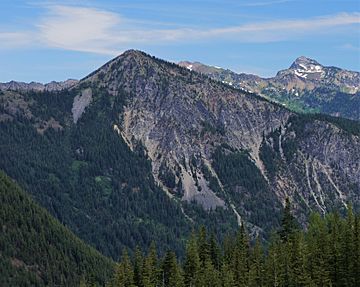Arrowhead Mountain (Washington) facts for kids
Quick facts for kids Arrowhead Mountain |
|
|---|---|

|
|
| Highest point | |
| Elevation | 6,030 ft (1,840 m) |
| Prominence | 550 ft (170 m) |
| Isolation | 2.45 mi (3.94 km) |
| Parent peak | Jim Hill Mountain (6,765 ft) |
| Geography | |
| Location | Chelan County Washington state, U.S. |
| Parent range | Chiwaukum Mountains Wenatchee Mountains Cascade Range |
| Topo map | USGS Mount Howard |
Arrowhead Mountain is a tall mountain in Chelan County, Washington state. It stands about 6,030 feet (1,838 meters) high. This peak is located about 6 miles (9.7 km) east of Stevens Pass. It sits right on the edge of the Alpine Lakes Wilderness. The land around it is managed by the Okanogan-Wenatchee National Forest.
Arrowhead Mountain is part of the Chiwaukum Mountains. These mountains are a smaller group within the larger Cascade Range. The closest taller mountain is Jim Hill Mountain, which is about 2.5 miles (4.0 km) to the southwest. Water from Arrowhead Mountain flows into Nason Creek. This creek then joins the Wenatchee River. The mountain got its name from Albert Hale Sylvester. He was a famous surveyor and explorer who named many places in the Cascade Mountains.
Understanding the Climate Around Arrowhead Mountain
Arrowhead Mountain is in a special climate zone called the marine west coast climate. This type of weather is common in western North America. Most of the weather systems that affect this area start over the Pacific Ocean. They then travel northeast towards the Cascade Range.
As these weather systems reach the tall Cascade Mountains, they are forced to rise. When air rises, it cools down and drops its moisture. This process is called orographic lift. Because of this, the western side of the Cascades gets a lot of rain or snow. This is especially true during the winter months.
In winter, the weather is often cloudy. However, during the summer, high-pressure systems over the Pacific Ocean become stronger. This often leads to clear skies and sunshine. Because the ocean influences the weather, the snow tends to be wet and heavy. This can sometimes create a risk of avalanches.
The Geology of Arrowhead Mountain
The Alpine Lakes Wilderness area, where Arrowhead Mountain is located, has very rugged land. You can see jagged peaks, sharp ridges, and deep valleys carved by glaciers. There are also huge granite rock walls and over 700 mountain lakes. The varied landscape and big changes in elevation were created by geological events long ago. These events also led to the different climates we see across the Cascade Range.
For example, Glacier Peak is a stratovolcano. This means it's a cone-shaped volcano built up by layers of ash and lava. It started forming about 25 miles (40 km) north-northwest of Arrowhead Mountain. This began during the middle of the Pleistocene epoch.
During the Pleistocene period, which was over two million years ago, huge sheets of ice called glaciers moved across the land many times. As they advanced and retreated, they scraped and shaped the landscape. They left behind piles of rock and debris. The last time glaciers retreated from the Alpine Lakes area was about 14,000 years ago. The "U"-shaped valleys you see in the rivers were formed by these glaciers. The combination of land uplift (when land rises) and faulting (cracks in the Earth's crust) along with glaciation has created the tall peaks and deep valleys of the Alpine Lakes Wilderness.



